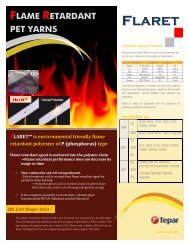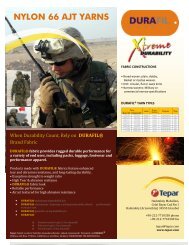Create successful ePaper yourself
Turn your PDF publications into a flip-book with our unique Google optimized e-Paper software.
Environmentally friendly and Flame Retardant PVC<br />
Polyester Coated Yarn<br />
• Flame Retardant<br />
• Odorless<br />
• Carcinogen-free PVC compound<br />
• The vinyl coating on the fibers gives the material added strength<br />
and durability<br />
• Antifungal & Antibacterial<br />
• Vinyl coated polyester is a very dimensionally stable fabric that<br />
does not tear easily, nor will it stretch, crack, rot or mildew.<br />
• The vinyl coating (PVC) makes it waterproof with a high<br />
resistance to dirt, mildew, oil, salt, chemicals and UV.<br />
• It can be sewn or heat sealed by way of RF(Radio Frequency)<br />
welding or hot-air welding<br />
Composition<br />
PVC 73,5%<br />
PET 26,5%<br />
Weight 0.105 g/m ( ± 0.003)<br />
Diameter<br />
⦰ 0.32 mm<br />
APPLICATIONS:<br />
• SUN SCREEN<br />
• AWNINGS<br />
• FLOORING<br />
• GARDEN FUNITURE<br />
• WALL COVERINGS<br />
• OTHERS<br />
www.tepar.com
PVC's Physical Properties<br />
PVC, PE, PP and PS are general purpose plastics. The features of the particular plastic are determined by its<br />
chemical composition and type of molecular structure (molecular formation: crystalline/amorphous structure)<br />
PVC has an amorphous structure with polar chlorine atoms in the molecular structure. Having chlorine atoms and<br />
the amorphous molecular structure are inseparably related. Although plastics seem very similar in the context of<br />
daily use, PVC has completely different features in terms of performance and functions compared with olefin<br />
plastics which have only carbon and hydrogen atoms in their molecular structures.<br />
Chemical stability is a common feature among substances containing halogens such as chlorine and fluorine.<br />
This applies to PVC resins, which furthermore possess fire retarding properties, durability, and oil/chemical<br />
resistance.<br />
Oil/Chemical resistance<br />
PVC is resistant to acid, alkali and almost all<br />
inorganic chemicals. Although PVC swells or<br />
dissolves in aromatic hydrocarbons, ketones,<br />
and cyclic ethers, PVC is hard to dissolve in<br />
other organic solvents. Taking advantage of<br />
this characteristic, PVC is used in exhaust gas<br />
ducts, sheets used in construction, bottles,<br />
tubes and hoses.<br />
Fire retarding properties<br />
PVC has inherently superior fire retarding properties due to<br />
its chlorine content, even in the absence of fire retardants.<br />
For example, the ignition temperature of PVC is as high as<br />
455°C, and is a material with less risk for fire incidents since<br />
it is not ignited easily .Furthermore, the heat released in<br />
burning is considerably lower with PVC, when compared<br />
with those for PE and PP. PVC therefore contributes much<br />
less to spreading fire to nearby materials even while<br />
burning.<br />
Therefore, PVC is very suitable for safety reasons in<br />
products close to people’s daily lives.<br />
www.tepar.com

















